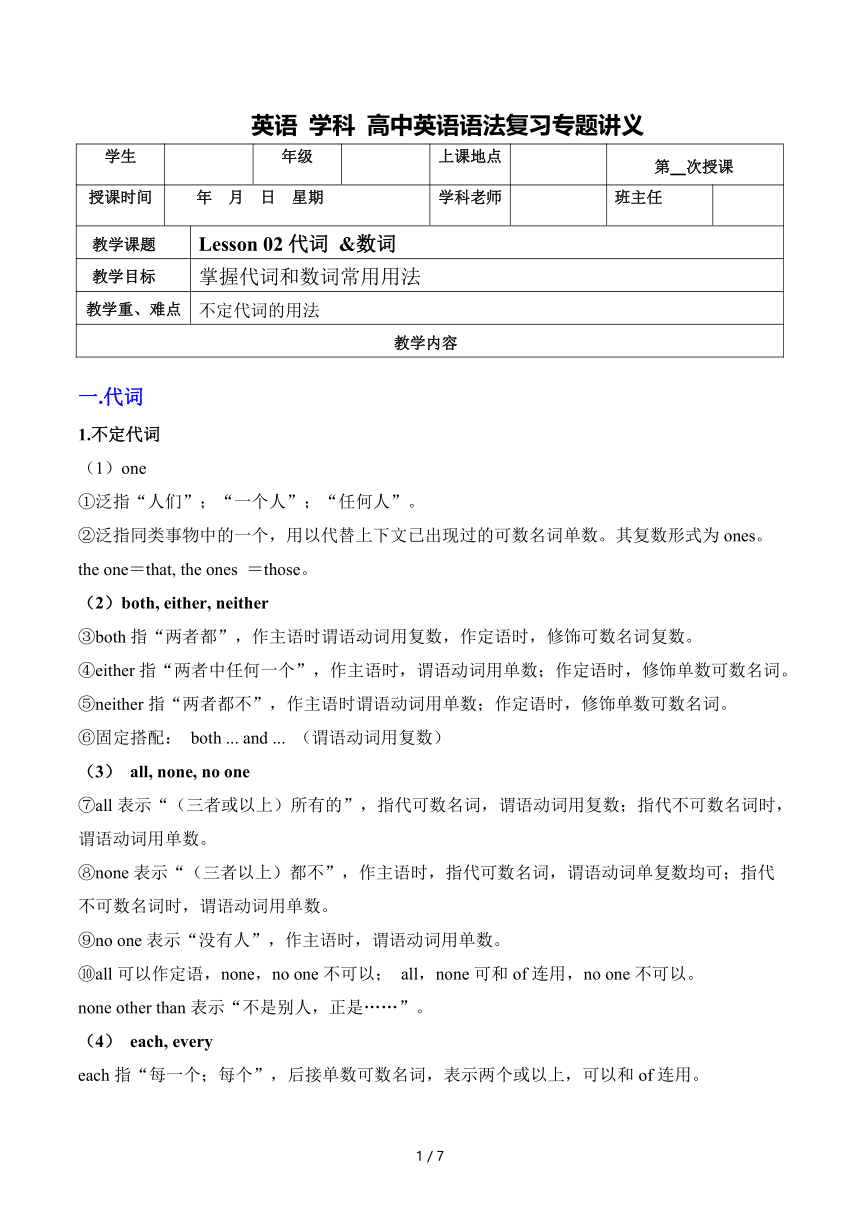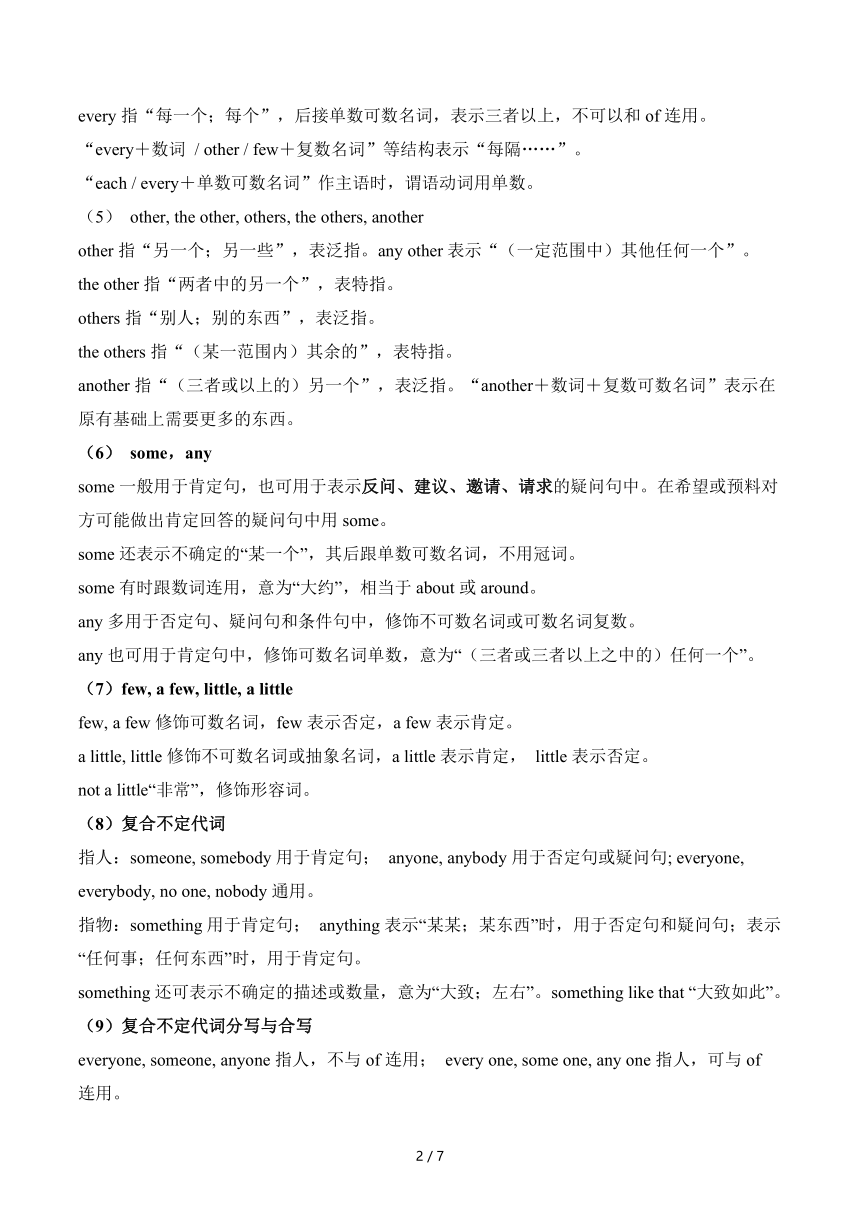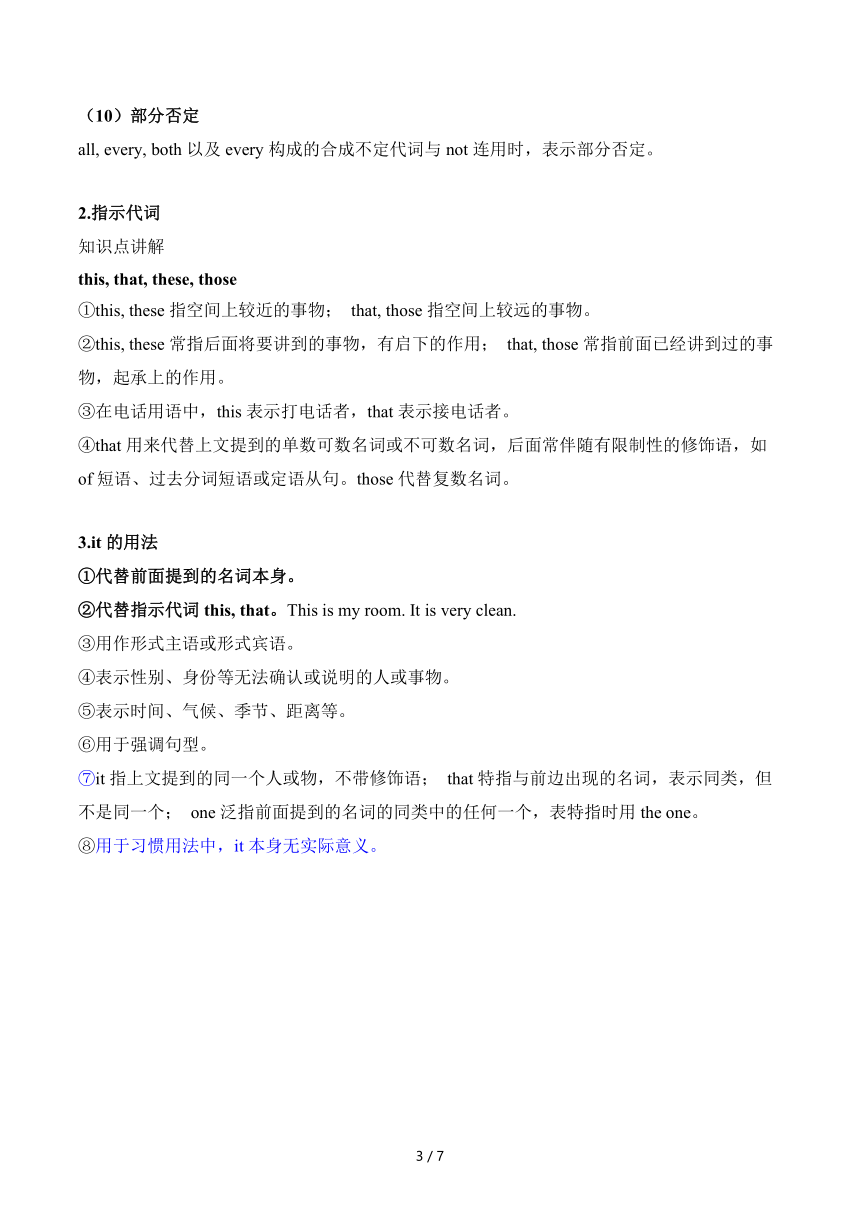2022届高考英语二轮复习:代词&数词 讲义(素材)
文档属性
| 名称 | 2022届高考英语二轮复习:代词&数词 讲义(素材) |  | |
| 格式 | docx | ||
| 文件大小 | 34.1KB | ||
| 资源类型 | 教案 | ||
| 版本资源 | 通用版 | ||
| 科目 | 英语 | ||
| 更新时间 | 2022-01-06 16:42:27 | ||
图片预览



文档简介
英语 学科 高中英语语法复习专题讲义
学生 年级 上课地点 第 次授课
授课时间 年 月 日 星期 学科老师 班主任
教学课题 Lesson 02代词 &数词
教学目标 掌握代词和数词常用用法
教学重、难点 不定代词的用法
教学内容
一.代词
1.不定代词
(1)one
①泛指“人们”;“一个人”;“任何人”。
②泛指同类事物中的一个,用以代替上下文已出现过的可数名词单数。其复数形式为ones。the one=that, the ones =those。
(2)both, either, neither
③both指“两者都”,作主语时谓语动词用复数,作定语时,修饰可数名词复数。
④either指“两者中任何一个”,作主语时,谓语动词用单数;作定语时,修饰单数可数名词。
⑤neither指“两者都不”,作主语时谓语动词用单数;作定语时,修饰单数可数名词。
⑥固定搭配: both ... and ... (谓语动词用复数)
(3) all, none, no one
⑦all表示“(三者或以上)所有的”,指代可数名词,谓语动词用复数;指代不可数名词时,谓语动词用单数。
⑧none表示“(三者以上)都不”,作主语时,指代可数名词,谓语动词单复数均可;指代不可数名词时,谓语动词用单数。
⑨no one表示“没有人”,作主语时,谓语动词用单数。
⑩all可以作定语,none,no one不可以; all,none可和of连用,no one不可以。
none other than表示“不是别人,正是……”。
(4) each, every
each指“每一个;每个”,后接单数可数名词,表示两个或以上,可以和of连用。
every指“每一个;每个”,后接单数可数名词,表示三者以上,不可以和of连用。
“every+数词 / other / few+复数名词”等结构表示“每隔……”。
“each / every+单数可数名词”作主语时,谓语动词用单数。
(5) other, the other, others, the others, another
other指“另一个;另一些”,表泛指。any other表示“(一定范围中)其他任何一个”。
the other指“两者中的另一个”,表特指。
others指“别人;别的东西”,表泛指。
the others指“(某一范围内)其余的”,表特指。
another指“(三者或以上的)另一个”,表泛指。“another+数词+复数可数名词”表示在原有基础上需要更多的东西。
(6) some,any
some一般用于肯定句,也可用于表示反问、建议、邀请、请求的疑问句中。在希望或预料对方可能做出肯定回答的疑问句中用some。
some还表示不确定的“某一个”,其后跟单数可数名词,不用冠词。
some有时跟数词连用,意为“大约”,相当于about或around。
any多用于否定句、疑问句和条件句中,修饰不可数名词或可数名词复数。
any也可用于肯定句中,修饰可数名词单数,意为“(三者或三者以上之中的)任何一个”。
(7)few, a few, little, a little
few, a few修饰可数名词,few表示否定,a few表示肯定。
a little, little修饰不可数名词或抽象名词,a little表示肯定, little表示否定。
not a little“非常”,修饰形容词。
(8)复合不定代词
指人:someone, somebody用于肯定句; anyone, anybody用于否定句或疑问句; everyone, everybody, no one, nobody通用。
指物:something用于肯定句; anything表示“某某;某东西”时,用于否定句和疑问句;表示“任何事;任何东西”时,用于肯定句。
something还可表示不确定的描述或数量,意为“大致;左右”。something like that “大致如此”。
(9)复合不定代词分写与合写
everyone, someone, anyone指人,不与of连用; every one, some one, any one指人,可与of连用。
(10)部分否定
all, every, both以及every构成的合成不定代词与not连用时,表示部分否定。
2.指示代词
知识点讲解
this, that, these, those
①this, these指空间上较近的事物; that, those指空间上较远的事物。
②this, these常指后面将要讲到的事物,有启下的作用; that, those常指前面已经讲到过的事物,起承上的作用。
③在电话用语中,this表示打电话者,that表示接电话者。
④that用来代替上文提到的单数可数名词或不可数名词,后面常伴随有限制性的修饰语,如of短语、过去分词短语或定语从句。those代替复数名词。
3.it的用法
①代替前面提到的名词本身。
②代替指示代词this, that。This is my room. It is very clean.
③用作形式主语或形式宾语。
④表示性别、身份等无法确认或说明的人或事物。
⑤表示时间、气候、季节、距离等。
⑥用于强调句型。
⑦it指上文提到的同一个人或物,不带修饰语; that特指与前边出现的名词,表示同类,但不是同一个; one泛指前面提到的名词的同类中的任何一个,表特指时用the one。
⑧用于习惯用法中,it本身无实际意义。
II.数词
基数词: 表示人或事物数量多少的词.
序数词: 表示人或事物的顺序的词.
一. 基数词.
1.基数词的读法.
1) 1---12: one two three four five six seven eight nine ten eleven twelve
2) 13---19: 词尾加-teen: thirteen fourteen fifteen sixteen seventeen eighteen nineteen
3) 20, 30, 40, 50, 60, 70, 80, 90: 逢十词尾加-ty: twenty thirty forty fifty sixty seventy eighty ninety
4) 21--99: 在十位与个位之间加连字符构成.
21--- twenty-one 99---ninety-nine
5) 101---999: 先说几百, 再加and ,再加末尾两位数或个位数.
101---one hundred and one 238----two hundred and thirty-eight
6) 1000以上的数: 先将数字从右往左数, 每三位数用一个逗号隔开, 从右往左第一个逗号表示 “千”读thousand 第二个逗号表示 “百万”读million 第三个逗号表示 “十亿”读billion
18, 657, 421---eighteen million, six hundred and fifty-seven thousand, four hundred and twenty-one.
二. 序数词
基数词变序数词
口诀:
基变序, 有规律, 词尾要加th;
一二三, 特殊记, 词尾分别tdd(first second third );
八去t , 九去e, ve要用f替;
ty变作tie, 再加th莫忘记.
若遇几十几, 只变个位就可以.
三. 数词的应用.
1.表编号.
结构: 名词(首字母要大写) + 基数词 = the +序数词 +名词
Lesson One = the first lesson
注:有些编号,一般仅用第一种表达法. Room 101 101号房间
2.序数词前一般加定冠词the,但序数词前与不定冠词a /an 连用时, 表示 “又一,再一”
3.数词前加every, 表示每…/每隔…
every ten days =every ninth day 每十天(每隔九天)
注:every +基数词+复数名词 = every + (序数词-1) +单数名词
4.基数词的复数形式表示年代和年龄
1)表示年代: in the +年份的复数, 在几世纪几十年代.
在十九世纪七十年代. in the 1970s.
2)表年龄: in one’s + 整十的复数, 表示在某人几十岁时
在他四十岁时: in his 40s
5. hundred / thousand /million /billion
1)若hundred / thousand /million /billion 前有基数词时, 其后不加s, 也不加of .若没有时, 既加s也要带of .
2)若其前有a few/many/several修饰时,通常用复数,后接of.
3)若名词前有the修饰时,用单数,后接of
Two hundred of the students in our school are from the countryside .
6.几个半的表达法:
基数词+ and + a half +名词复数 = 基数词 +名词(单数/复数) +and +a half
two and a half hours = two hours and a half
7.时刻表达法:
1)整点: 基数词 + o’clock
2)几点几分:
A)直接读法: 先读小时, 后读分钟 3:25--three twenty-five
B)间接读法:
a)≤30分钟. 分钟+ past + 小时 3:25--twenty-five past three
b)>30分钟. ( 60-分钟 )+ to + (小时数+1) 3:55--five to four
c) 30 分钟= half 15分钟=a quarter 45分钟= three quarters
3:30 --half past three 3:15--a quarter past three 3:45 ----a quarter to four
8.日期表达法:
结构: 1).月, 日, 年 (日用序数词, 年用基数词)
注:年份的读法: 先读前两位数,再读后两位数. 读日时要加the.
1900---nineteen hundred
1807----eighteen and seven (eighteen o seven)
2008---two thousand eight
2007年3月21日.--- March the twenty-first, two thousand and seven.
2)日 月 年 (the +序数词+of +月, 年)
2007年3月21日---the twenty-first of March, two thousand and seven.
9.分数词的表达法:
1)结构:
a).分子用基数词,分母用序数词.
b)当分子大于1时, 分母加复数.
3/4--three fourths (three-fourths)
2)注意:
a)分数词的几种特殊形式.
1/3—one third = a third 1/4—one fourth = a quarter
1/2—one second = a half 3/4—three fourths = three quarters
b)分数词作主语时, 谓语动词根据分数词后面的名词来确定.
Two fifths of the milk is drunk by Tom .
One third of the students are girls .
学生 年级 上课地点 第 次授课
授课时间 年 月 日 星期 学科老师 班主任
教学课题 Lesson 02代词 &数词
教学目标 掌握代词和数词常用用法
教学重、难点 不定代词的用法
教学内容
一.代词
1.不定代词
(1)one
①泛指“人们”;“一个人”;“任何人”。
②泛指同类事物中的一个,用以代替上下文已出现过的可数名词单数。其复数形式为ones。the one=that, the ones =those。
(2)both, either, neither
③both指“两者都”,作主语时谓语动词用复数,作定语时,修饰可数名词复数。
④either指“两者中任何一个”,作主语时,谓语动词用单数;作定语时,修饰单数可数名词。
⑤neither指“两者都不”,作主语时谓语动词用单数;作定语时,修饰单数可数名词。
⑥固定搭配: both ... and ... (谓语动词用复数)
(3) all, none, no one
⑦all表示“(三者或以上)所有的”,指代可数名词,谓语动词用复数;指代不可数名词时,谓语动词用单数。
⑧none表示“(三者以上)都不”,作主语时,指代可数名词,谓语动词单复数均可;指代不可数名词时,谓语动词用单数。
⑨no one表示“没有人”,作主语时,谓语动词用单数。
⑩all可以作定语,none,no one不可以; all,none可和of连用,no one不可以。
none other than表示“不是别人,正是……”。
(4) each, every
each指“每一个;每个”,后接单数可数名词,表示两个或以上,可以和of连用。
every指“每一个;每个”,后接单数可数名词,表示三者以上,不可以和of连用。
“every+数词 / other / few+复数名词”等结构表示“每隔……”。
“each / every+单数可数名词”作主语时,谓语动词用单数。
(5) other, the other, others, the others, another
other指“另一个;另一些”,表泛指。any other表示“(一定范围中)其他任何一个”。
the other指“两者中的另一个”,表特指。
others指“别人;别的东西”,表泛指。
the others指“(某一范围内)其余的”,表特指。
another指“(三者或以上的)另一个”,表泛指。“another+数词+复数可数名词”表示在原有基础上需要更多的东西。
(6) some,any
some一般用于肯定句,也可用于表示反问、建议、邀请、请求的疑问句中。在希望或预料对方可能做出肯定回答的疑问句中用some。
some还表示不确定的“某一个”,其后跟单数可数名词,不用冠词。
some有时跟数词连用,意为“大约”,相当于about或around。
any多用于否定句、疑问句和条件句中,修饰不可数名词或可数名词复数。
any也可用于肯定句中,修饰可数名词单数,意为“(三者或三者以上之中的)任何一个”。
(7)few, a few, little, a little
few, a few修饰可数名词,few表示否定,a few表示肯定。
a little, little修饰不可数名词或抽象名词,a little表示肯定, little表示否定。
not a little“非常”,修饰形容词。
(8)复合不定代词
指人:someone, somebody用于肯定句; anyone, anybody用于否定句或疑问句; everyone, everybody, no one, nobody通用。
指物:something用于肯定句; anything表示“某某;某东西”时,用于否定句和疑问句;表示“任何事;任何东西”时,用于肯定句。
something还可表示不确定的描述或数量,意为“大致;左右”。something like that “大致如此”。
(9)复合不定代词分写与合写
everyone, someone, anyone指人,不与of连用; every one, some one, any one指人,可与of连用。
(10)部分否定
all, every, both以及every构成的合成不定代词与not连用时,表示部分否定。
2.指示代词
知识点讲解
this, that, these, those
①this, these指空间上较近的事物; that, those指空间上较远的事物。
②this, these常指后面将要讲到的事物,有启下的作用; that, those常指前面已经讲到过的事物,起承上的作用。
③在电话用语中,this表示打电话者,that表示接电话者。
④that用来代替上文提到的单数可数名词或不可数名词,后面常伴随有限制性的修饰语,如of短语、过去分词短语或定语从句。those代替复数名词。
3.it的用法
①代替前面提到的名词本身。
②代替指示代词this, that。This is my room. It is very clean.
③用作形式主语或形式宾语。
④表示性别、身份等无法确认或说明的人或事物。
⑤表示时间、气候、季节、距离等。
⑥用于强调句型。
⑦it指上文提到的同一个人或物,不带修饰语; that特指与前边出现的名词,表示同类,但不是同一个; one泛指前面提到的名词的同类中的任何一个,表特指时用the one。
⑧用于习惯用法中,it本身无实际意义。
II.数词
基数词: 表示人或事物数量多少的词.
序数词: 表示人或事物的顺序的词.
一. 基数词.
1.基数词的读法.
1) 1---12: one two three four five six seven eight nine ten eleven twelve
2) 13---19: 词尾加-teen: thirteen fourteen fifteen sixteen seventeen eighteen nineteen
3) 20, 30, 40, 50, 60, 70, 80, 90: 逢十词尾加-ty: twenty thirty forty fifty sixty seventy eighty ninety
4) 21--99: 在十位与个位之间加连字符构成.
21--- twenty-one 99---ninety-nine
5) 101---999: 先说几百, 再加and ,再加末尾两位数或个位数.
101---one hundred and one 238----two hundred and thirty-eight
6) 1000以上的数: 先将数字从右往左数, 每三位数用一个逗号隔开, 从右往左第一个逗号表示 “千”读thousand 第二个逗号表示 “百万”读million 第三个逗号表示 “十亿”读billion
18, 657, 421---eighteen million, six hundred and fifty-seven thousand, four hundred and twenty-one.
二. 序数词
基数词变序数词
口诀:
基变序, 有规律, 词尾要加th;
一二三, 特殊记, 词尾分别tdd(first second third );
八去t , 九去e, ve要用f替;
ty变作tie, 再加th莫忘记.
若遇几十几, 只变个位就可以.
三. 数词的应用.
1.表编号.
结构: 名词(首字母要大写) + 基数词 = the +序数词 +名词
Lesson One = the first lesson
注:有些编号,一般仅用第一种表达法. Room 101 101号房间
2.序数词前一般加定冠词the,但序数词前与不定冠词a /an 连用时, 表示 “又一,再一”
3.数词前加every, 表示每…/每隔…
every ten days =every ninth day 每十天(每隔九天)
注:every +基数词+复数名词 = every + (序数词-1) +单数名词
4.基数词的复数形式表示年代和年龄
1)表示年代: in the +年份的复数, 在几世纪几十年代.
在十九世纪七十年代. in the 1970s.
2)表年龄: in one’s + 整十的复数, 表示在某人几十岁时
在他四十岁时: in his 40s
5. hundred / thousand /million /billion
1)若hundred / thousand /million /billion 前有基数词时, 其后不加s, 也不加of .若没有时, 既加s也要带of .
2)若其前有a few/many/several修饰时,通常用复数,后接of.
3)若名词前有the修饰时,用单数,后接of
Two hundred of the students in our school are from the countryside .
6.几个半的表达法:
基数词+ and + a half +名词复数 = 基数词 +名词(单数/复数) +and +a half
two and a half hours = two hours and a half
7.时刻表达法:
1)整点: 基数词 + o’clock
2)几点几分:
A)直接读法: 先读小时, 后读分钟 3:25--three twenty-five
B)间接读法:
a)≤30分钟. 分钟+ past + 小时 3:25--twenty-five past three
b)>30分钟. ( 60-分钟 )+ to + (小时数+1) 3:55--five to four
c) 30 分钟= half 15分钟=a quarter 45分钟= three quarters
3:30 --half past three 3:15--a quarter past three 3:45 ----a quarter to four
8.日期表达法:
结构: 1).月, 日, 年 (日用序数词, 年用基数词)
注:年份的读法: 先读前两位数,再读后两位数. 读日时要加the.
1900---nineteen hundred
1807----eighteen and seven (eighteen o seven)
2008---two thousand eight
2007年3月21日.--- March the twenty-first, two thousand and seven.
2)日 月 年 (the +序数词+of +月, 年)
2007年3月21日---the twenty-first of March, two thousand and seven.
9.分数词的表达法:
1)结构:
a).分子用基数词,分母用序数词.
b)当分子大于1时, 分母加复数.
3/4--three fourths (three-fourths)
2)注意:
a)分数词的几种特殊形式.
1/3—one third = a third 1/4—one fourth = a quarter
1/2—one second = a half 3/4—three fourths = three quarters
b)分数词作主语时, 谓语动词根据分数词后面的名词来确定.
Two fifths of the milk is drunk by Tom .
One third of the students are girls .
